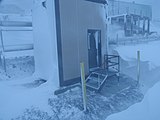Antarctica Weather Danger Classification
Appearance
The weather in Antarctica can be highly variable, and weather conditions will oftentimes change dramatically in a short period of time. Weather conditions on the continent are classified in a number of ways, and restrictions placed upon workers and other staffs vary both by stations and by nations.[1]
McMurdo Station (USA)[2][3][4]
[edit]| Condition | Criteria | Example |
|---|---|---|
| Condition 3 / Normal Condition 3[5][6] |
Must meet all of the following criteria:
|

|
| Condition 2 / Severe Condition 2[5][6] |
Must meet all of the following criteria:
And also must meet one or more of the following criteria:
|

|
| Condition 1 / Severe Condition 1[5][6] |
Must meet one or more of the following criteria:
|

|
Scott Base (New Zealand)[7]
[edit]| Condition | Criteria |
|---|---|
| Weather Condition 3 | Must meet all of the following criteria:
|
| Weather Condition 2 | Must meet all of the following criteria:
And also must meet one or more of the following criteria:
|
| Weather Condition 1 | Must meet one or more of the following criteria:
|
References
[edit]- ^ "Antarctic weather – Australian Antarctic Program". www.antarctica.gov.au. 2019-02-18. Retrieved 2024-03-31.
- ^ "Welcome To McMurdo Station" (PDF). U.S. National Science Program. Archived from the original (PDF) on 2014-09-10.
- ^ "Field Manual for the U.S. Antarctic Program" (PDF). U.S. Antarctic Program. Archived from the original (PDF) on 2007-03-06.
- ^ Howard, George (1997-10-18). "Winter Storm: Weathering the Conditions" (PDF). The Antarctic Sun. p. 8. Retrieved 2024-03-31.
- ^ a b c Ferrier, Cara; Walker, Meghan; Webster, Kaija. Mastro, Jim (ed.). "Field Manual for the U.S. Antarctic Program" (PDF). United States Antarctic Program. Retrieved 2024-03-31.
- ^ a b c "Weather Condition Definitions". lambda.gsfc.nasa.gov. Retrieved 2024-03-31.
- ^ Field Manual: 2011-2013 (PDF). New Zealand: Antarctica New Zealand. 2012. Archived from the original (PDF) on 2015-01-15.
{{cite book}}: CS1 maint: date and year (link)
